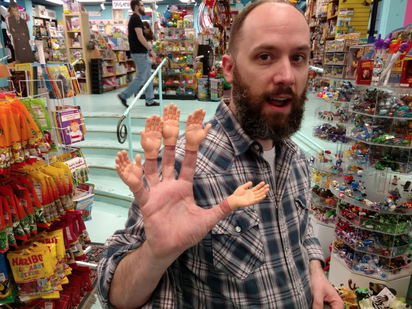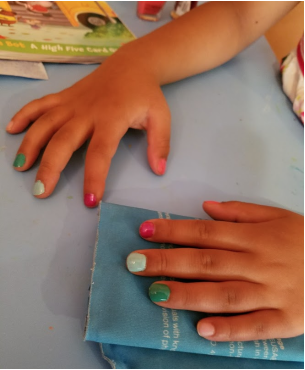|
This week's content is provided by Brian Bushart, an incredible person and father of a budding 4.5 year-old mathematician. If you have not yet checked out his work, do it now! From Brian: I have a confession to make. Promise not to laugh. I still count on my fingers. There. I said it. The guy who’s taught elementary school and developed middle school math curriculum counts on his fingers. Sure, I know how to do loads of math in my head, but that doesn’t stop me from regularly pulling out my fingers to help me out in my daily life. It’s like I was born to use them to do math. Oh wait. I was! Turns out, according to brain science, that even if we aren’t using fingers as we calculate, an area of the brain lights up that is actually “seeing” fingers! Not only that, but a child's early knowledge of fingers can be a better predictor of math performance than tests. We’re born with our fingers, and we put them to use immediately making sense of the world around us: grabbing, touching, pulling. They are a tool in so many ways, including in mathematics, even as we get older. That’s why my four and a half year old daughter and I talk about, count, and play with our fingers every chance we get. Do I want her to learn efficient computation strategies later in her life? Sure! But I also know the importance of a solid foundation of counting and quantity, especially super useful numbers like 5 and 10. Oh hey, I’ve got those right here on my hand! One of my favorite games I like to play with my daughter is “How many fingers am I holding up?” The trick is that I’m holding my hand up against my chest so she can’t see my fingers, usually while I’m driving. She makes a guess - she’s got a 1 in 5 chance of being right - and then I pop up my fingers so she can check to see if her guess is correct. At first she always had to count each of my fingers, but over time she’s learned to recognize 1, 2, or 3 fingers without counting them at all. In general, not just with fingers, she’s getting better at instantly recognizing those quantities without counting one by one. It was so cool to see her start doing this! As she gets more and more comfortable with 4 and 5, she’ll start to count those less and less and begin to recognize them right away as well. Another game I like to play is Fast Five. I tell her, “Do you want me to show you 5 really fast?” She says yes. I hold my hand behind my back and say, “Ready...set...fast five!” Then I quickly pull my hand from behind my back with all five fingers up. She counts my fingers, and, wouldn’t you know it, it’s always five. She doesn’t know it yet, which is why we keep playing, but eventually she is just going to know that there are 5 fingers on a hand.
In the meantime, we’re having fun talking about numbers and she’s learning more and more about this really cool tool she’s got attached to her body that she carries with her everywhere. Before too long we’ll be moving on to Fast Ten and other games that use two hands. I can’t wait! For older kids, I will hold up three fingers on one hand and two on another: "How many different numbers can we create from these two?" It seems simple, but gets more challenging as you learn about different operations. Try it; how many values can you create? If you’d like to try out some fun activities with your child to help build knowledge of their fingers, check out this collection from YouCubed, an organization at Stanford University. How are you doing this with your child(ren) at home? Feel free to drop a comment below and share. Also, remember to sign up for the FREE weekly newsletter!
0 Comments
Your comment will be posted after it is approved.
Leave a Reply. |
Details
AuthorJohn Stevens is working to give parents ideas on how to have mathematics-based discussion at home. Archives
May 2018
Categories |



 RSS Feed
RSS Feed